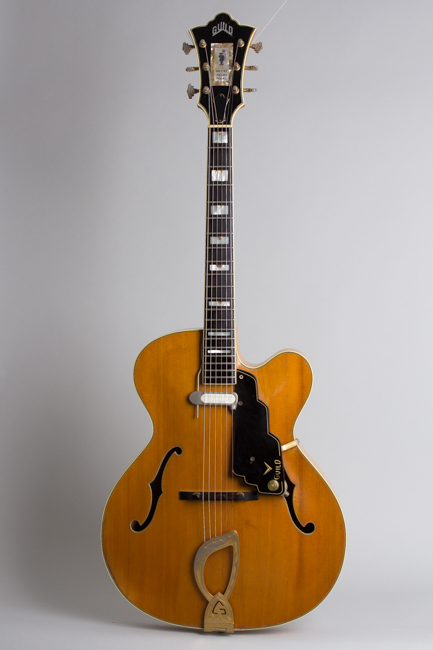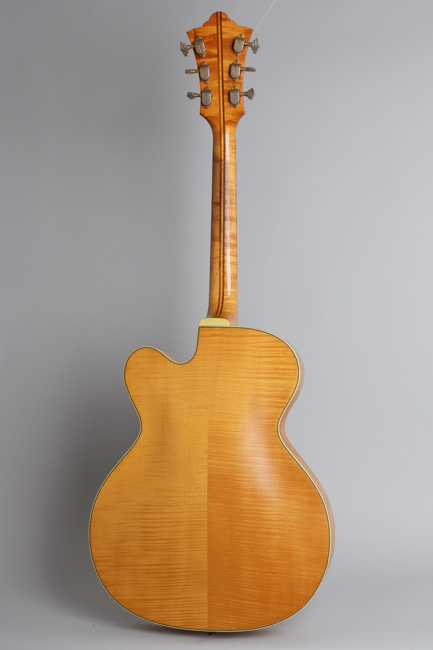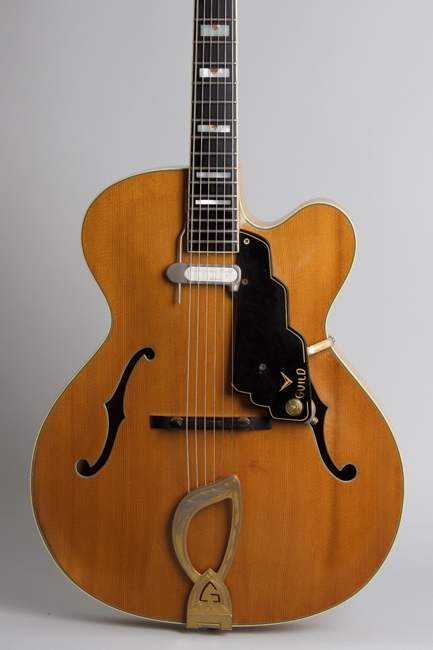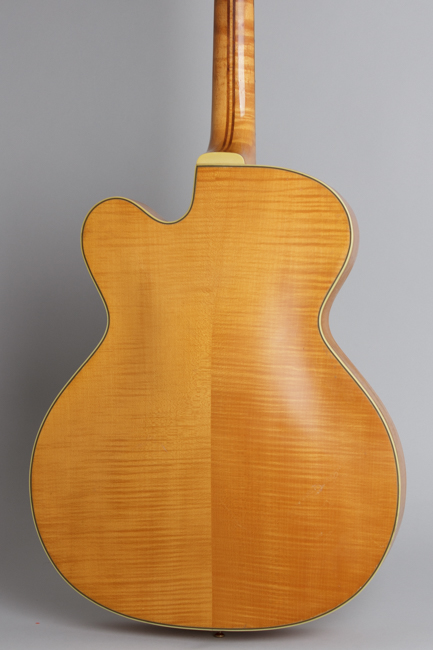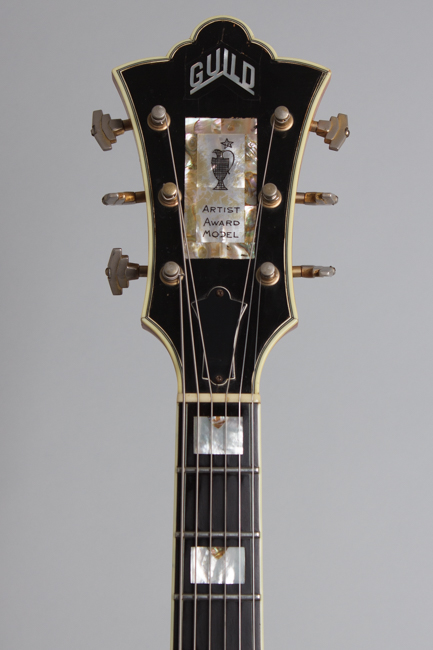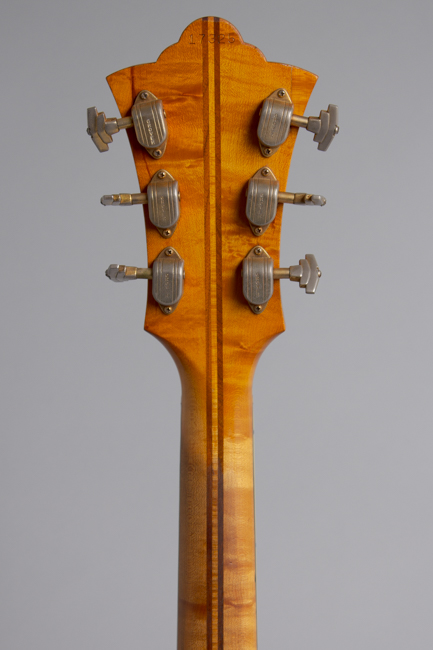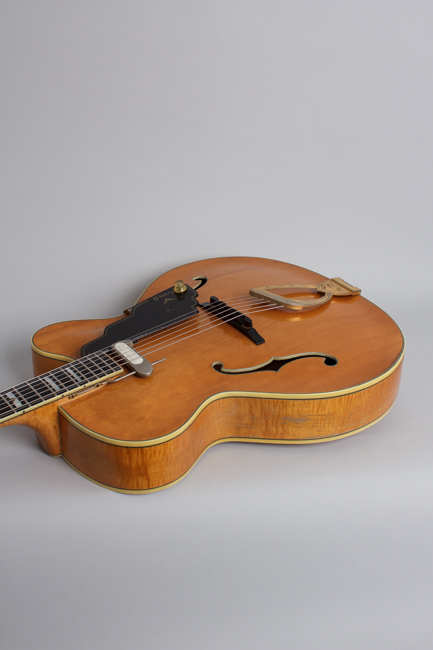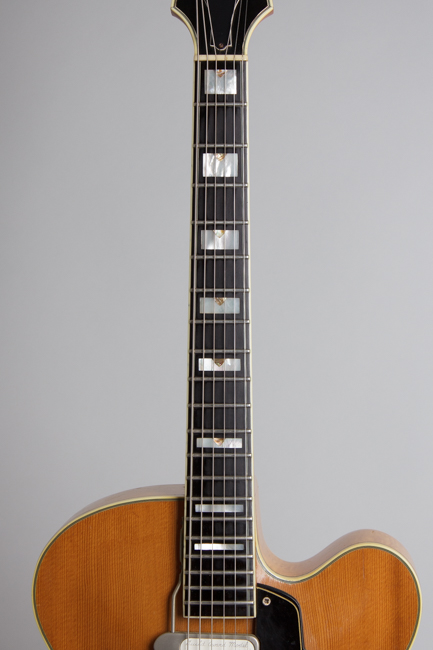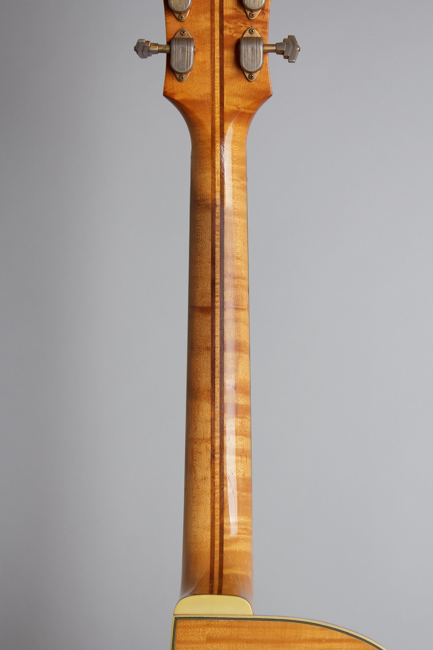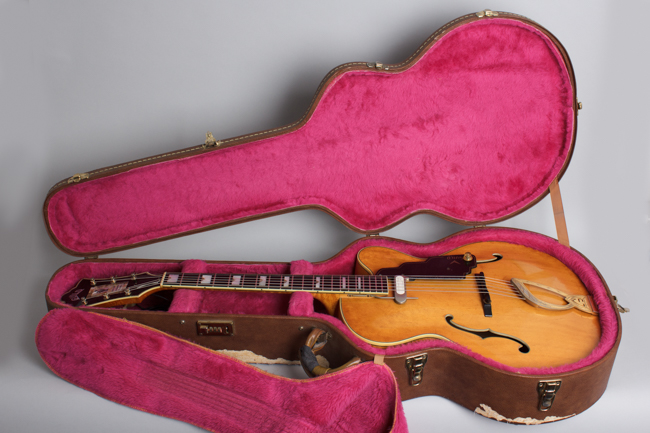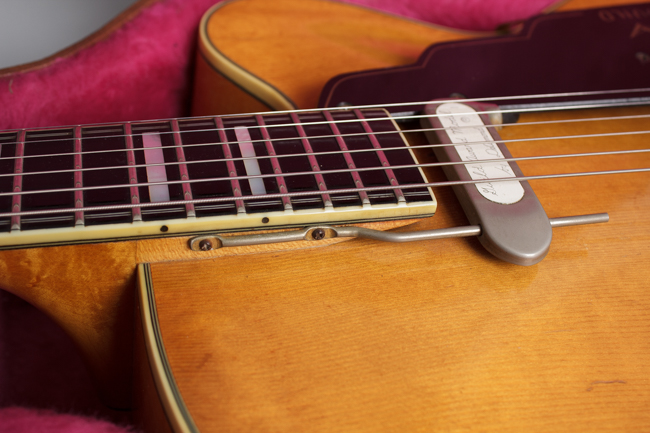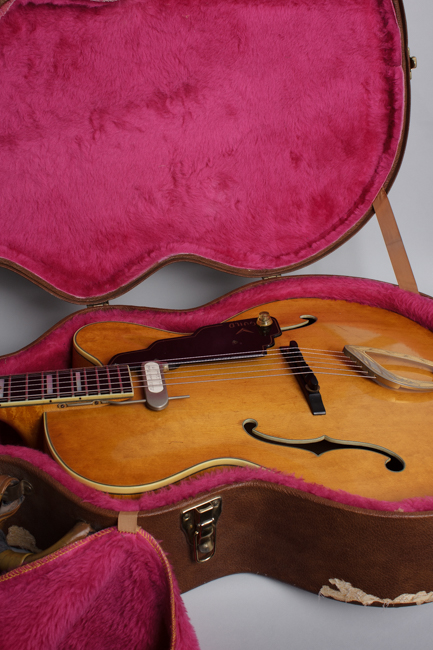Guild Artist Award B w/floating DeArmond pickup Arch Top Acoustic Guitar (1961)
Guild Artist Award B w/floating DeArmond pickup Model Arch Top Acoustic Guitar (1961), made in Hoboken, NJ, serial # 17325, natural lacquer finish, maple back and sides, spruce top; laminated maple neck with ebony fingerboard, brown tolex hard shell case.
The Guild Artist Award model in natural finish was the absolute top of the company's line in the 1960s and for founder Al Dronge represented the pinnacle of his firm's achievement. It is a carved cutaway acoustic arch-top guitar with a floating DeArmond pickup and very fancy trim, intended to compete directly with Gibson and even John D'Angelico's finest offerings.
The Artist Award was originally intended to be a namesake model for jazz great Johnny Smith, but a disagreement between Smith and the Guild foreman about how the top of the guitar should be carved led to him nullifying the agreement. The Guild "Johnny Smith Award" model was marketed from 1956-1959, but although pictured with the guitar in publicity materials, the artist refused to actively play it. Smith later admitted the instrument itself was not so much the issue; rather, he felt that as the designer and endorser of the guitar, his preferences should have been followed to the letter, and Al Dronge did not choose to back him up on that. Smith moved his endorsement to Gibson in 1960 and the "Artist Award" name was substituted on the Guild.
Whatever its original namesake's reservations, the Artist Award represents Guild's finest hour as an arch-top guitar builder and one of the best acoustic/electric carved guitars ever made. The full-depth 17" body is made of curly maple with a carved spruce top, 5-ply bound on the top and back and 3-ply bound on the sides. The f-holes are bound as well. The neck shows its Epiphone ancestry with a 5-piece lamination down the back and bound ebony fretboard inlaid with "Emperor-style" split pearl and abalone blocks. The large elaborate center-peak headstock is multi-bound on the face with an inlaid abalone-bordered pearl centerpiece showing the engraved logo "Artist Award Model' and an etched trophy cup. All hardware except the pickup rig is gold-plated, including the Grover imperial tuners and the engraved Guild harp tailpiece. The DeArmond Rhythm chief model 1000 is a special white-topped version made expressly for this model, with engraving to that effect on the plastic insert piece.
As a very expensive instrument (The blonde model listed at $675 in 1961-2, and up to $725 the next year), the Artist Award was only made in very limited numbers. Production figures are not available for the early 1960s; between 1965-69, the model averaged only between 10 and 20 units each year. The sound is comparable to similar D'Angelico or Gibson instruments from the same period, and the guitar plays and handles extremely well. George Benson endorsed this model in the 1960s, and it remained Guild's most prestigious offering into the 1970s and beyond. This blonde 1961 model is an early example, a very rare guitar and extremely fine instrument. It remains a world-class piece, an exceptional performance guitar for the lower-volume settings it was designed for.
Overall length is 43 1/4 in. (109.9 cm.), 17 in. (43.2 cm.) wide at lower bout, and 3 1/8 in. (7.9 cm.) in depth, measured at side of rim. Scale length is 24 3/4 in. (629 mm.). Width of nut is 1 11/16 in. (43 mm.).
This 60+ year old guitar has been fairly seriously played over the decades and so shows some general wear but remains all original with no alterations. There are dings, dents and scrapes to the finish overall, most noticeably some deeper dinks and scrapes on the spruce top behind and below the pickguard, with armwear to the expected spot on the upper rim. The upper side shows some finish loss from moisture, the back has some buckle wear into the finish but nothing too heavy. The back of the neck shows finish worn down to the wood along the center seam.
The guitar has no visible cracks or repairs. All hardware is original and correct including the clear back-painted Lucite pickguard with the white-topped floating DeArmond pickup and controls. The Grover Imperial tuners and engraved harp tailpiece show some typical plating loss. The name "R J Cox" is very lightly etched in the peghead veneer under the Guild logo. The original frets have been crowned down somewhat and show subsequent wear but still play well. The ebony fingerboard has some very minor divoting. An older mini-Amphenol cord for the pickup is included. This beautiful blonde instrument is certainly as fine a guitar as Guild has ever made -- a testament to the very best the Hoboken company had to offer in the 1960s. Overall Excellent - Condition.
The Guild Artist Award model in natural finish was the absolute top of the company's line in the 1960s and for founder Al Dronge represented the pinnacle of his firm's achievement. It is a carved cutaway acoustic arch-top guitar with a floating DeArmond pickup and very fancy trim, intended to compete directly with Gibson and even John D'Angelico's finest offerings.
The Artist Award was originally intended to be a namesake model for jazz great Johnny Smith, but a disagreement between Smith and the Guild foreman about how the top of the guitar should be carved led to him nullifying the agreement. The Guild "Johnny Smith Award" model was marketed from 1956-1959, but although pictured with the guitar in publicity materials, the artist refused to actively play it. Smith later admitted the instrument itself was not so much the issue; rather, he felt that as the designer and endorser of the guitar, his preferences should have been followed to the letter, and Al Dronge did not choose to back him up on that. Smith moved his endorsement to Gibson in 1960 and the "Artist Award" name was substituted on the Guild.
Whatever its original namesake's reservations, the Artist Award represents Guild's finest hour as an arch-top guitar builder and one of the best acoustic/electric carved guitars ever made. The full-depth 17" body is made of curly maple with a carved spruce top, 5-ply bound on the top and back and 3-ply bound on the sides. The f-holes are bound as well. The neck shows its Epiphone ancestry with a 5-piece lamination down the back and bound ebony fretboard inlaid with "Emperor-style" split pearl and abalone blocks. The large elaborate center-peak headstock is multi-bound on the face with an inlaid abalone-bordered pearl centerpiece showing the engraved logo "Artist Award Model' and an etched trophy cup. All hardware except the pickup rig is gold-plated, including the Grover imperial tuners and the engraved Guild harp tailpiece. The DeArmond Rhythm chief model 1000 is a special white-topped version made expressly for this model, with engraving to that effect on the plastic insert piece.
As a very expensive instrument (The blonde model listed at $675 in 1961-2, and up to $725 the next year), the Artist Award was only made in very limited numbers. Production figures are not available for the early 1960s; between 1965-69, the model averaged only between 10 and 20 units each year. The sound is comparable to similar D'Angelico or Gibson instruments from the same period, and the guitar plays and handles extremely well. George Benson endorsed this model in the 1960s, and it remained Guild's most prestigious offering into the 1970s and beyond. This blonde 1961 model is an early example, a very rare guitar and extremely fine instrument. It remains a world-class piece, an exceptional performance guitar for the lower-volume settings it was designed for.
Overall length is 43 1/4 in. (109.9 cm.), 17 in. (43.2 cm.) wide at lower bout, and 3 1/8 in. (7.9 cm.) in depth, measured at side of rim. Scale length is 24 3/4 in. (629 mm.). Width of nut is 1 11/16 in. (43 mm.).
This 60+ year old guitar has been fairly seriously played over the decades and so shows some general wear but remains all original with no alterations. There are dings, dents and scrapes to the finish overall, most noticeably some deeper dinks and scrapes on the spruce top behind and below the pickguard, with armwear to the expected spot on the upper rim. The upper side shows some finish loss from moisture, the back has some buckle wear into the finish but nothing too heavy. The back of the neck shows finish worn down to the wood along the center seam.
The guitar has no visible cracks or repairs. All hardware is original and correct including the clear back-painted Lucite pickguard with the white-topped floating DeArmond pickup and controls. The Grover Imperial tuners and engraved harp tailpiece show some typical plating loss. The name "R J Cox" is very lightly etched in the peghead veneer under the Guild logo. The original frets have been crowned down somewhat and show subsequent wear but still play well. The ebony fingerboard has some very minor divoting. An older mini-Amphenol cord for the pickup is included. This beautiful blonde instrument is certainly as fine a guitar as Guild has ever made -- a testament to the very best the Hoboken company had to offer in the 1960s. Overall Excellent - Condition.
